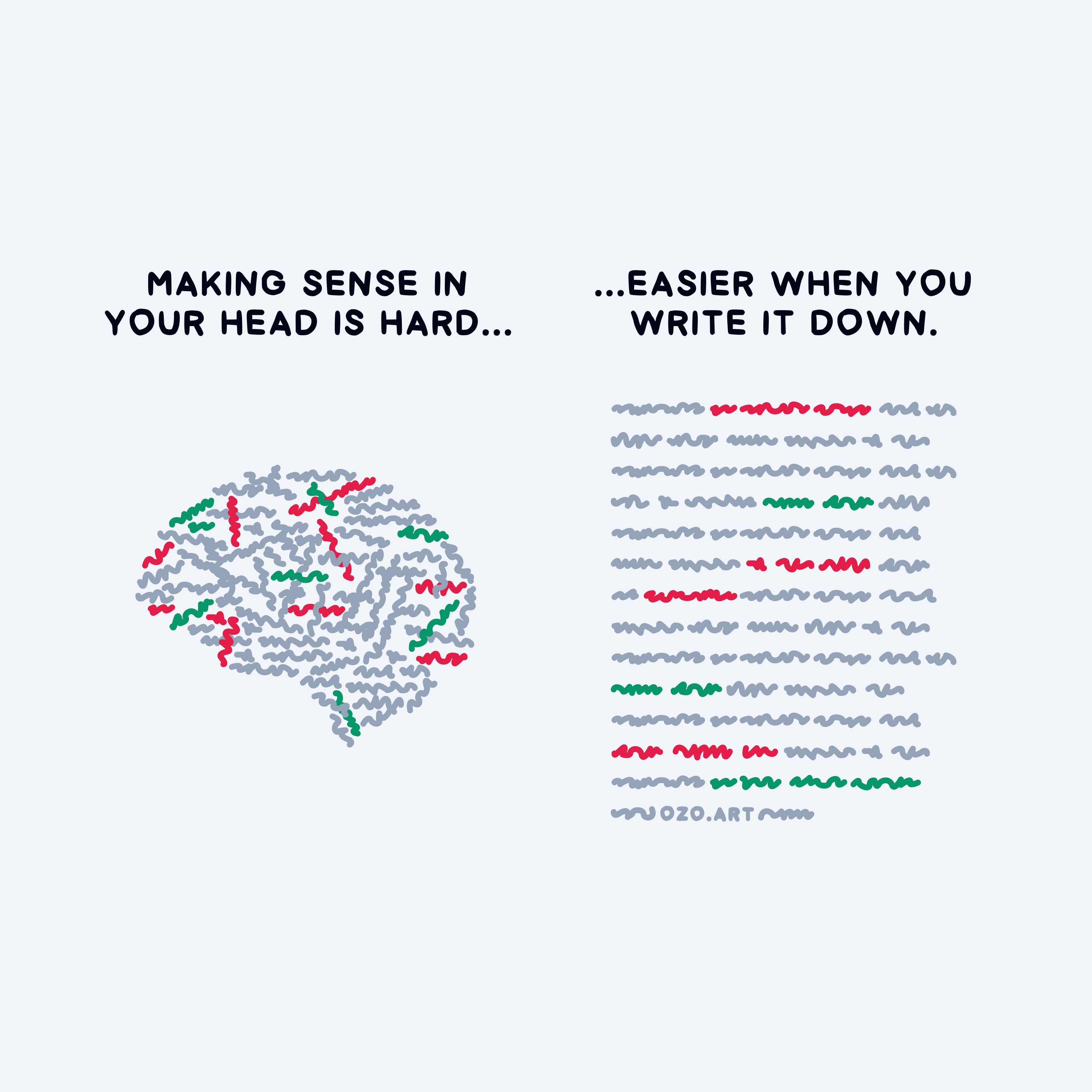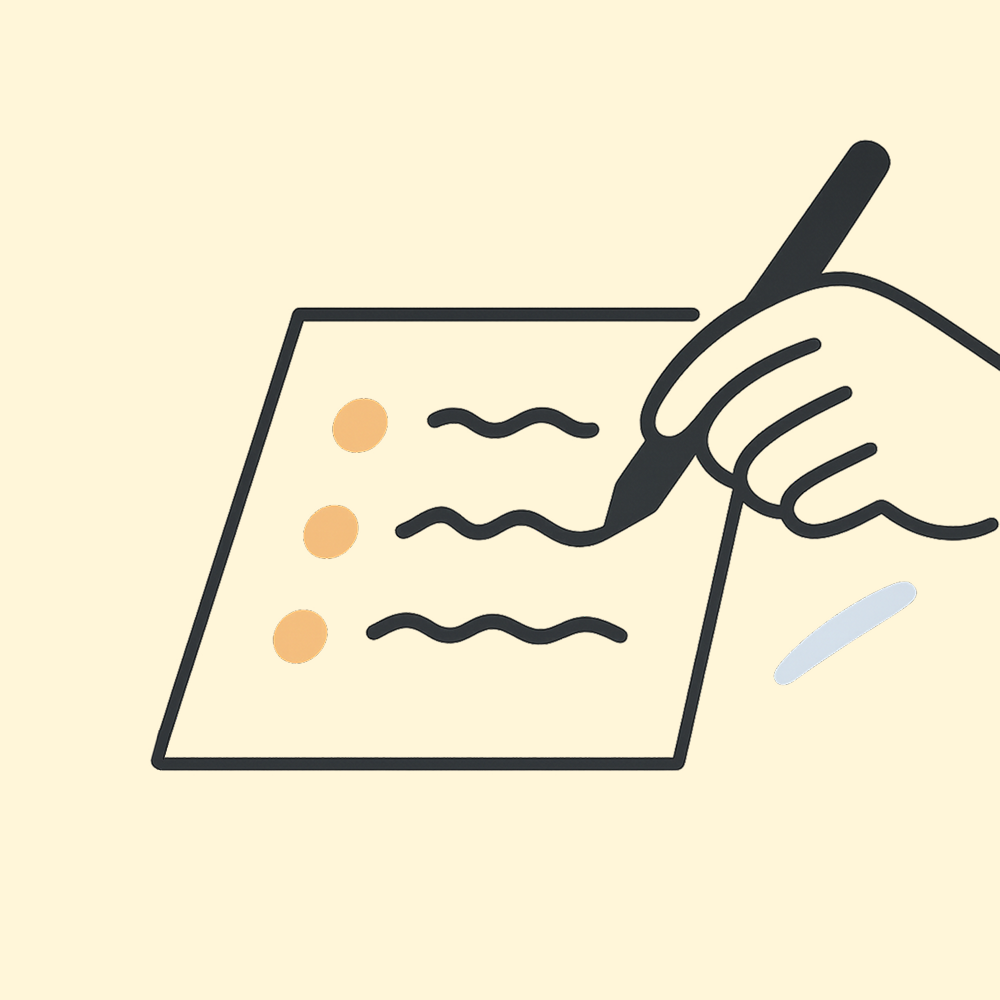At its core, good communication is about translating your internal thoughts into something others can clearly grasp. Whether you’re putting together a case study or presentation or drafting a message in Slack, the challenge is always the same: How do you express your idea clearly?
The truth is, expressing ideas is hard—even when they feel crystal clear in your head. You sit down to write, confident in your message. But suddenly, it all gets messy. You rewrite the same sentence five times, struggle to find the right words, and still feel like you’re not quite saying what you mean.
That’s not a failure.

That’s the real work of writing: turning something abstract into something tangible and understandable. And the hardest part? It’s juggling all the pieces—what you want to say, how to say it, and how it fits together—all at once.
The cognitive load of communication
When we try to write or speak clearly, we’re making a lot of decisions at the same time:
- What is the core message?
- In what order should I present the information?
- How do I keep it clear, concise, and engaging?
Doing all this simultaneously is exhausting. It’s a heavy cognitive load, especially when staring at a blank page or blinking cursor. That’s where most people get stuck.
Designers constantly communicate; it’s a core part of our work. Whether through planning documents, Slack messages, or presentations, your ideas live or die by how well you communicate them.
And good instincts aren’t always enough.

What an outline does
Here’s the good news: an outline reduces the mental strain. It separates the “thinking” from the “writing.”
Instead of trying to shape and structure your message simultaneously, an outline lets you break your idea into smaller, manageable parts—each with a clear purpose and place. This is where clarity begins.
At its most basic, outlining helps you:
- Organize your thoughts
- Identify gaps, redundancies, or weak spots
- Visualize the structure before writing paragraphs
- Maintain logical flow and narrative arc
You can think of it as scaffolding—a temporary structure that supports your thinking while the final message is still in progress.
Outlining gives you a solid base, especially when making presentations or detailed documents.

Outlining is a tool for speed and focus
Speed is an often overlooked benefit of outlining
Once you’ve built your outline, you no longer guess what to say next. You’re not pausing to question the structure. You’re focused on shaping, polishing, and executing the message.
This leads to:
- Faster writing: You already know the flow.
- Clearer thinking: You’ve filtered out irrelevant pieces.
- Stronger impact: Your structure supports your story.
No matter what you’re trying to create, structure gives your message room to breathe. It guides your audience through your logic, making your ideas easier to absorb.

How to use outlines to communicate better
Outlining is easy!
You don’t need a complicated system. You only need to think through a few key questions to build a quick outline.
- What’s the main point?
- What are 2–3 supporting ideas?
- What’s the most logical order?
Your outline doesn’t have to be polished. Use rough bullet points, fragments, or short notes. This isn’t the final product—it’s your thinking space.
Here’s a simple example:
- Supporting: lack of agenda, unclear goals, too many participants
- Order: identify the problem → explain root causes → share solutions
This structure gives your brain a concrete model to work with and your audience an easy format to understand.
Why structure works across mediums
The benefits of outlining aren’t limited to formal essays or big presentations. They apply everywhere:
- Slack messages
- Planning docs
- Emails
- Case studies
- Presentations
- Meeting agendas
- Product specs
- Article drafts
- User research summaries
Anytime you need to explain something clearly.
No matter the medium, starting with a structure clarifies early and helps you build momentum faster. It enables you to start from a place of true intention.
Cognitive psychology backs this up. Research shows that our working memory is limited, and trying to juggle too many ideas at once causes overload. Outlining helps offload that mental burden so your brain can focus on reasoning and clarity.
It also improves retention for both the writer and the reader.

FAQs: Why expressing ideas is hard and outlining helps
Why is expressing ideas so difficult?
Because you’re juggling multiple decisions—what to say, how to say it, and in what order—all at once. That mental load makes it hard to communicate clearly.
How does outlining help communication?
Outlining reduces cognitive load by giving your ideas structure. It helps organize thoughts, spot gaps, and focus on execution rather than chaos.
Do I need to outline every time I write?
Not necessarily, but even a quick, rough outline can make your communication clearer and faster.
Is outlining only for long-form writing?
No. Outlining is useful for emails, Slack messages, plans, and informal notes. It’s a flexible tool for all communication.
What if I don’t stick to my outline?
That’s okay. The outline is a guide, not a contract. Its purpose is to get you started and reduce your feeling overwhelmed.
How can designers benefit from outlining?
Designers must often explain rationale, pitch ideas, or present user flows. Structure helps them communicate more effectively across teams.
Final thoughts: Clarity starts with structure
Expressing ideas is hard—not because you lack clarity but because clarity takes work. Outlining is one of the simplest, most effective tools for making that work easier.
It’s not about perfection. It’s about creating space to think clearly, communicate purposefully, and write with direction.
Make outlining a habit. It’ll sharpen your communication, strengthen your thinking, and accelerate your writing.






